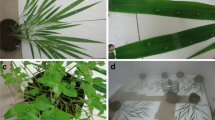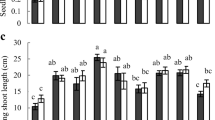Abstract
An isolate of Altemaria crassa obtained from Datura stramonium was tested for its potential as a mycoherbicide in south-eastem Australia. Sporulation of A. crassa in culture was greatest under the following conditions: on V-8 juice agar, with a 12 h photoperiod of ‘Warm White’ light, with cultures arranged in a monolayer, at 25–30°C, at about 13 days after inoculation. Spores rather than mycelial fragments were required to kill seedlings of D. stramonium. Preliminary experiments indicated that a minimum dew period of 9 h and a spore concentration of 105/mL were required to kill cotyledonary-stage seedlings of D. stramonium. In host range studies in the glasshouse, A. crassa killed or severely reduced the growth of all Datura species tested and other solanaceous weeds. Also, A. crassa caused disease symptoms on some crops and ornamental species, including four tomato and two eggplant cultivars, Petunia × hybrida ‘Mardi Gras’ and a soybean cultivar. Microscopic examination of the infection process after inoculation showed that spores germinated, formed appressoria and penetrated equally well on different species and so resistance was intracellular. This local isolate of A. crassa is potentially an effective mycoherbicide for D. stramonium and other solanaceous weeds in south-eastem Australia.
Similar content being viewed by others
References
Anonymous. (1992) — Australian Wheat Board Wheat Receival Standards, 1991192 Season, section 4.
Auld, B.A. and Medd, R.W. (1987) — Weeds: an illustrated botanicalguide to the weeds ofAustralia. Inkata Press, Melbourne.
Bowers, R.C. (1982) — Commercialization of microbial biological control agents. In Biologicalcontrolof weeds with plant pathogens (Eds R. Charudattan and R.L. Walker), pp. 157–173. John Wiley and Sons, New York.
Boyette, C.D. (1986) — Evaluation of Altemaria crassa for biological control of jimsonweed: host range and virulence. Plant Science 45: 223–228.
Boyette, C.D., Quimby Jr, P.C., Connick Jr, W.J., Daigle, D.J. and Fulgham, F.E. (1991a) — Progress in the production, formulation and application of mycoherbicides. In Microbial Control of Weeds (Ed D.O. TeBeest), pp. 209–222. Chapman and Hall, New York.
Boyette, C.D. and Turfitt, L.B. (1988) — Factors influencing biocontrol ofjimsonweed (Datura stramonium L.) with the leaf-spotting fungus Altemaria crassa. Plant Science 56: 261–264.
Boyette, C.D., Weidemann, G.J., TeBeest, D.O, and Quimby Jr, P.C. (1991b) — Biological control of jimsonweed (Datura stramonium) with Alternaria crassa. Weed Science 39: 678–681.
Bruzzese, E. and Hasan, S. (1986) — Host specificity of the rust Phragmidium violaceum, a potential biological control agent of European blackberry. Annals of Applied Biology 108: 585–596.
Ellingboe, A.H. (1968) — Inoculum production and infection by foliage pathogens. Annual Review of Phytopathology 6: 317–330.
Felton, W.L. (1974) — Control of Datura stramonium L. with oxadiazon under simulated spray and furrow irrigation. Weed Research 14: 209–212.
Kenney, D.S. (1986) — DeVine — the way it was developed — an industrialist’s view. Weed Science 34 (Suppl. 1): 15–16.
Lamp, C. and Collet, F. (1976) — A Field Guide to Weeds in Australia. Inkata Press, Melbourne.
Leonard, K.J. (1982) — The benefits and potential hazards of genetic heterogeneity in plant pathogens. In Biological Control of Weeds with Plant Pathogens (Eds R. Charudattan and R.L. Walker), pp. 99–112. John Wiley and Sons, New York.
Miller, P.M. (1955) — V-8 juice agar as a general-purpose medium for fungi and bacteria. Phytopathologv 45: 461–462.
Omar, M.B., Bolland, L. and Heather, W.A. (1978) — A permanent mounting medium for fungi. Stain Technologv 53: 293–294.
Parsons, W.T. and Cuthbertson, E.G. (1992) — Noxious Weeds of Australia. Inkata Press, Melbourne.
Reisman-Berman, O., Kigel, J. and Rubin, B. (1991) — Dormancy patterns in buried seeds of Datura ferox and Datura stramonium. Canadian Journal of Botany 69: 173–179.
Tuite, J. (1969) — Plant Pathological Methoak — Fungiand Bacteria. Burgess, Minneapolis.
Walker, H.L. (1982) — Seedling blight of sicklepod caused by Alternaria cassiae. Plant Disease 66: 426–428.
Wapshere, A.J. (1974) — A strategy for evaluating the safety of organisms for biological weed control. Annals of Applied Biology 77: 201–211.
Watson, A.K. (1985) — Host specificity of plant pathogens in biological weed control. Proceedings of the First International Weed Control Congress (Melbourne), pp. 577–586.
Author information
Authors and Affiliations
Rights and permissions
About this article
Cite this article
Stewart-Wade, S.M., Lawrie, A.C. & Bmese, E. An Australian isolate of Alternaria crassa shows potential as a mycoherbicide to control the weed Datura stramonium . Australasian Plant Pathology 27, 186–197 (1998). https://doi.org/10.1071/AP98021
Received:
Accepted:
Issue Date:
DOI: https://doi.org/10.1071/AP98021




